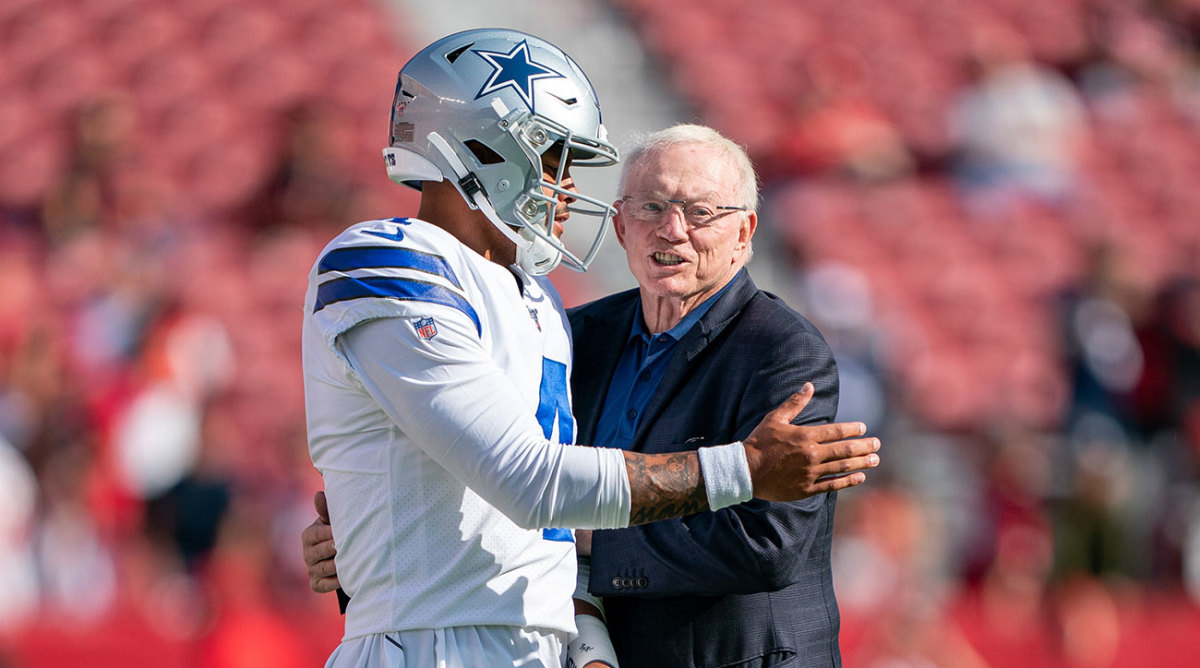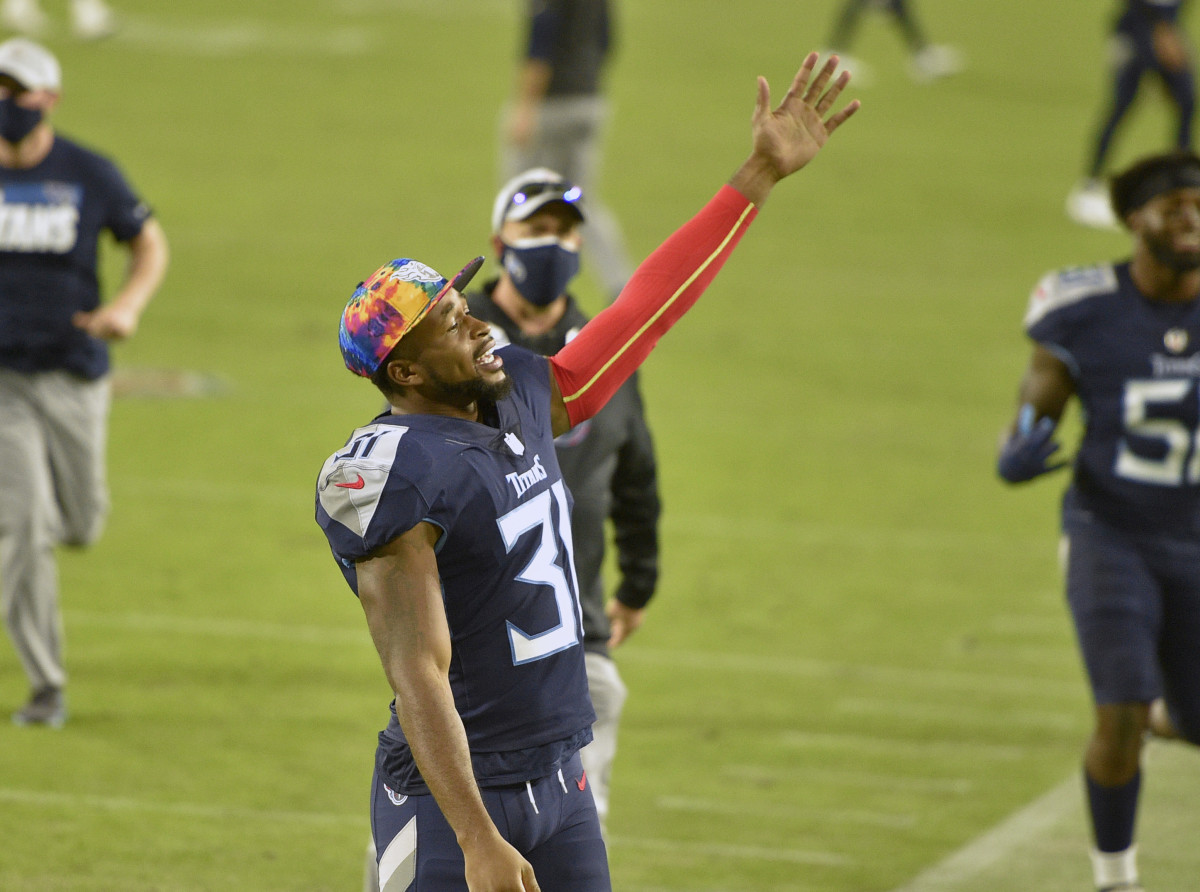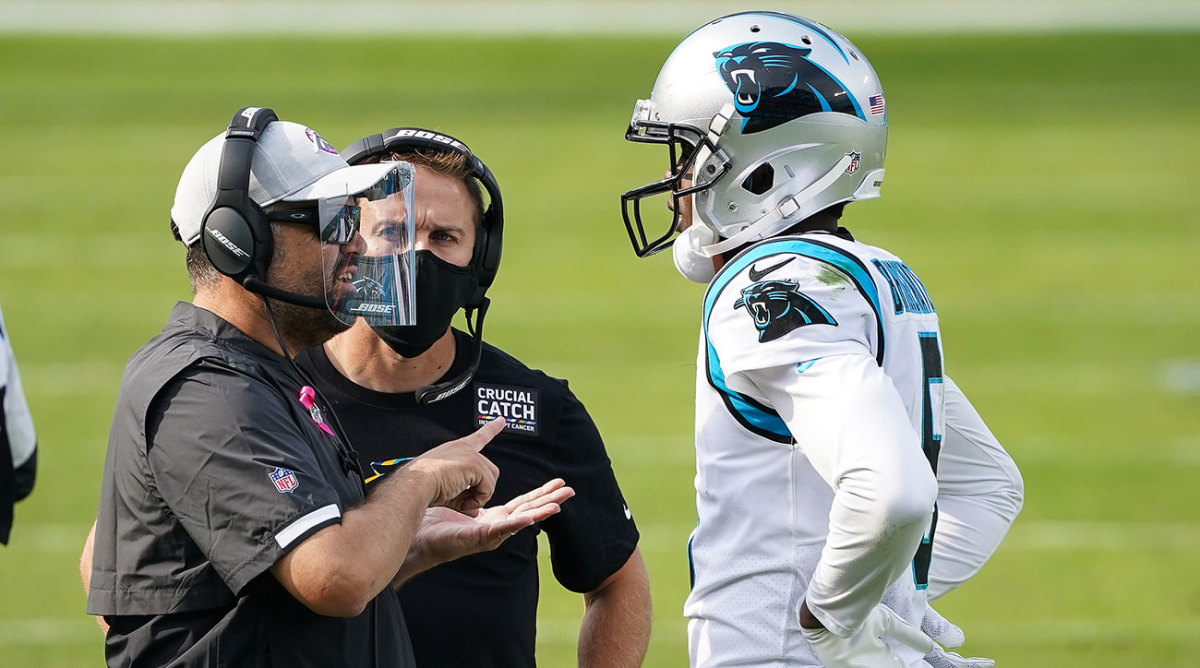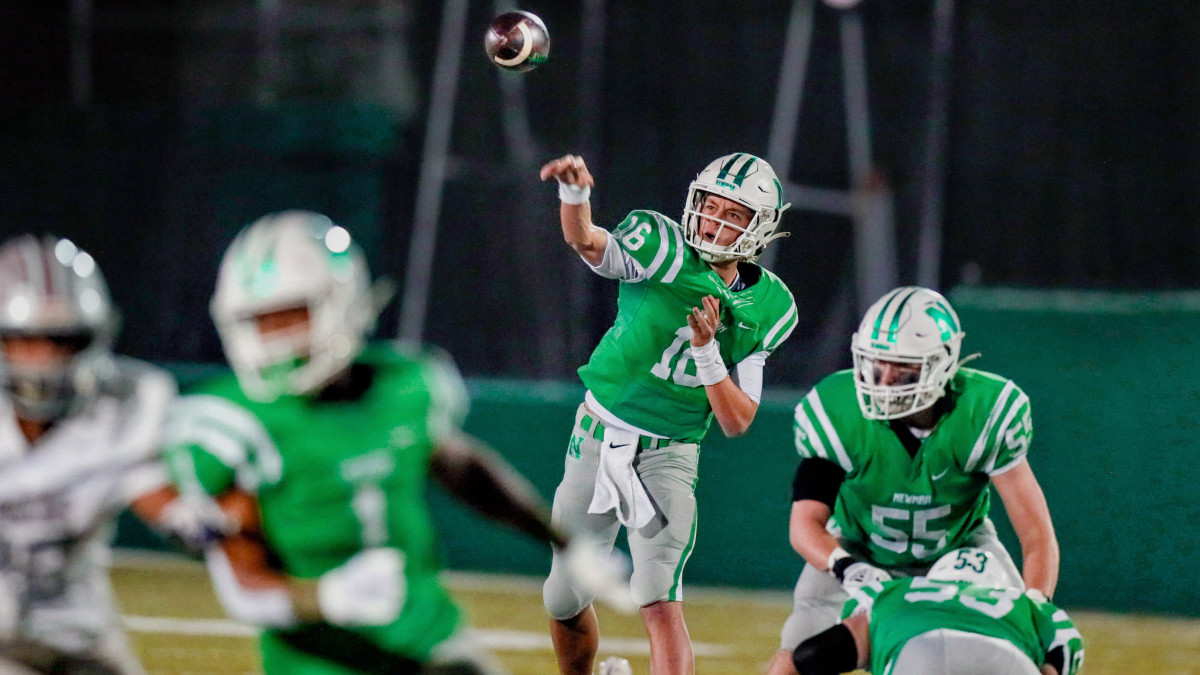Stephen Jones Says Dak Prescott's Injury Doesn't Affect His Contract Negotiation
Between the time Cowboys QB Dak Prescott’s right leg collapsed under the weight of Giants DB Logan Ryan, Prescott was carted back to the locker room, transported to a local hospital and operated on, there wasn’t much time for many of those involved to contemplate the injury’s long-term ramifications.
At that point, concern was with Prescott, and the focus was on getting him everything he needed in the moment. Which is why Cowboys owner Jerry Jones and COO Stephen Jones left their box the minute the cart pulled off the field—as Dallas’s game against the Giants resumed—and headed for the elevators to meet their quarterback in the bowels of AT&T Stadium. They caught him just before he was loaded into the ambulance.
The conversation was private. But the sentiment was obvious.
“Anytime you see that type of injury that can happen in our game, we’ve had them from everybody from Alex Smith to Joe Theismann, to have it happen to somebody that’s your own—on your own team—it breaks your heart,” Stephen Jones said over the phone Wednesday night. “Dak being our leader in every way, it magnified the situation even more. It’s just very, very difficult, knowing how much he loves the game, how much he loves to compete, how much he wants to win for this team.
“When you saw that, you knew that he was gonna be done for this year, you didn’t need to talk to a doctor or anything like that. There was finality as far as this year is concerned.”
Now, four days later, the reality of the long-term situation can be considered.
The Cowboys and Prescott’s camp have, for 18 months or so, tried to get a long-term deal done. Their failure to do so meant Prescott was playing on the final year of his rookie deal in 2019, at just over $2 million, and on the exclusive version of the franchise tag this year, with the price ballooning to $31.409 million. So no matter what happened with Dallas this fall, Prescott’s contract situation was going to linger over it.
As Jones said, now everyone has finality on that part of it. We know Prescott won’t play again this year. We also know that when, by rule of the franchise tag, negotiations can pick back up after Dallas’s season ends, Prescott will still be rehabbing.
And as Jones and I spoke, I figured that could cloud the situation come January or February.
Instead, Jones told me the team’s approach to Prescott won’t be shaken, even a little.
“Doesn’t change anything,” he said. “We’re all in on trying to get it done. Doesn’t change a thing.”
Then, I raised another tag—which would cost $37.7 million—and the point was driven home.
“Like I said, nothing changes,” he said “There is zero change in his contract negotiation status, how much we want to get him signed. Nothing changes. He didn’t lose value. Nothing. It’s a continually work in progress. Obviously, it’s been a challenge for us, in that we haven’t gotten it done, especially with how bad I know he wants to be a Cowboy.
“And I know how bad we want him to be the leader of this team for the next 10, 12 years.”
So in case you were wondering where the Cowboys stand, there it is.

***
Week 6 has been retrofitted—we get no Thursday night game, and two Monday night games this week—and we’re here to prepare you for it. Inside this week’s GamePlan …
• How the Titans’ players rallied, and what they showed everyone.
• Who Matt Rhule might be helping with his Panthers’ breakthrough.
• Power rankings!
• Some football that will be played on Thursday night (you’ll like this one).
But we’re starting with the Cowboys, Prescott and where the franchise goes from here.
***
The next question here then would be fairly obvious: If the Cowboys feel this strongly about Prescott, why didn’t they already sign him?
It’s a fair one, too, and there’s detail here—and this isn’t from my conversation with Jones—that may not be particularly entertaining for the average football fan thinking that contract disputes happen like Rod Tidwell’s did in Jerry Maguire.
Basically, the heart of the problem between the Cowboys and Prescott came down to years. In most other sports, where contracts are fully guaranteed, players want longer-term deals because that means more security. In football, the opposite is true. Because the biggest deals for the brightest stars usually guarantee money through only three years, every year past that becomes a de facto team option.
Accordingly, Prescott and his agents wanted a four-year extension, like the deals that Russell Wilson has done in Seattle—in fact, my understanding is something around Wilson’s deal (money and everything) would’ve been sufficient in the spring. The problem was the precedent Dallas had set in insisting on longer deals with stars like Ezekiel Elliott, Zack Martin, Tyron Smith, Jaylon Smith and DeMarcus Lawrence.
So the sides could never bridge that gap, which had very little to do with what the Cowboys thought of Prescott as a player and a person.
That part of the equation wasn’t a problem. In fact, the Cowboys saw how Prescott handled the impasse—the kind that often can cause friction with players—as further affirmation of who their quarterback is.
“It’s a full body of work,” Jones said. “He continues to build on how much respect he gets, how much we think of him, not only as a player but as a person, as a leader, a face of the organization, it only increases with each month that passes. You just continue to gain respect for him as you go. He handles adversity like no other. He’s just a special man.”
And so Jones has no doubt that whatever Prescott can do to get back better than ever he will do in the coming months. “I don’t want to, in any way, underplay the severity of the injury. But the normal prognosis for something like this is four to six months. Betting on Dak, he always seems to be on the low side of something like that.”
The scene on the field in the aftermath of the injury showed, again, why. The respect that Prescott commands, and has earned, was pretty clear.
***
And this is where we can go back from the future to this year.
What Dallas is losing was illustrated perfectly out there on the AT&T Stadium turf. It wasn’t just Cowboys teammates going over to see Prescott. It was the Giants, too. And not even just the guys who knew him—New York had more than a couple.
“Obviously, the severity of the injury was very clear,” Jones said. “I know people who saw it, and could see it, just from a box in the stadium. You could tell immediately. And then you take the respect that this league has for Dak. Not even the people who know him, that goes without saying, [Giants and ex-Dallas coaches] Jason Garrett or Marc Colombo or Derek Dooley, the people who know him were there.
“But just the overall respect from people who just admire what he’s done, and what a worker that he is and what a leader that he is, there’s just such respect for him. And that’s the reason.”
Now, taking all of this into account, the flip side is that Dallas has been here before. More important than just that, the Cowboys learned from it.
When Tony Romo broke his collarbone in Week 2 of 2015, a season that started with so much promise went careening into a ditch. There were plenty of factors (Greg Hardy was definitely one), but the biggest issue, without question, in Dallas’s inability to weather Romo’s injury was its depth issue behind the starter. Brandon Weeden got the first crack at it, Matt Cassel was then signed to replace him and Cassel was eventually benched in favor of Kellen Moore, with Romo also making a brief—and failed—bid at returning in the middle of all that.
That was a big reason for the Cowboys to make quarterback depth a focus in 2016 draft, which is how Dallas wound up with Prescott. And the idea of building out the room past the starter was only reaffirmed with Mike McCarthy’s arrival in Dallas.
The ex-Packers coach, Jones explained, made it clear from the start that he wanted to add a veteran and draft a developmental prospect at the position. So when Andy Dalton became available at an affordable rate, the decision to pursue him was academic. "Great news for us, Andy was ready to come back to Texas, so turned out it was in play,” Jones said. “Great opportunity for us, and he wanted to be here. Couldn’t have worked out any better.”
So going forward, the Cowboys have a roster they believed could compete for a title in 2020 with Prescott at the helm—with the deep investment in the core as proof of that feeling—and now go to a quarterback who’s been to the playoffs five times, and is still just 32 years old. That’s why, when I asked Jones whether he feels fortunate to have Dalton, he didn’t even let me finish the question.
“No, very fortunate. Very fortunate,” Jones said. “Same type of guy, class act, leader, been there, done that, obviously led his team to the playoffs. Not unlike the Cowboys as of late, hasn’t won a lot of playoff games. But he certainly got his team there with the opportunity to do it. We’re just fortunate to have that type of guy here ready to step in. I know his teammates have total respect for him and confidence in him.”
And for that reason, he sees the season as far from over.
“[Defensive coordinator] Mike Nolan made some adjustments that help our personnel and certainly our players are embracing and executing his defense better,” he continued. “And certainly, the offense has been good throughout. I think Andy gave you a glimpse there at the end, leading us down the field, I think he was 9-of-11. In the heat of the battle, crunch time, he played well. So I’ve got all the confidence in the world in this team.”
So yeah, a lot did change on Sunday afternoon in Arlington.
But, if you listen to Jones, plenty also stayed the same.
***
POWER RANKINGS
1) Green Bay Packers (4–0): This team is coming off a bye, and I can’t wait for Packers–Bucs on Sunday. Brady–Rodgers is always a fantastic show, and I expect nothing less from this one.
2) Seattle Seahawks (5–0): I’m a little uneasy about the Seahawks’ defense still, but what Russell Wilson is doing on a week-to-week basis is enough to keep Seattle moving up the list.
3) Tennessee Titans (4–0): That was impressive. Buffalo was down its starting corners, but the overall effort from Tennessee, and the style with which it won, says pretty loudly that Mike Vrabel’s crew isn’t going away after the team’s outbreak.
4) Pittsburgh Steelers (4–0): That Browns–Steelers is on the marquee this week is great. It’s been a long, long time since one of the NFL’s best rivalries held the sort of importance in the standings that Sunday’s game will carry.
5) Kansas City Chiefs (4–1): I’m willing to consider the loss to the Raiders as a blip, but concerns on K.C.’s offensive line remain. And the defense, for the first time all year, looked like the old Chiefs’ defenses (not a good thing). The Bills will provide a nice test late on Monday afternoon.
***

THE BIG QUESTION
How did the Titans pull THAT off?
We can start here: Football coaches will use just about anything for motivation, so the NFL put this one on a tee for Mike Vrabel. As his players saw it, on Monday night, he drove that thing 300 yards in addressing them in a way that humanized what they’d been through over the two weeks previous.
Indeed, they were dealing with the stress of the team’s COVID-19 outbreak and fingers pointed squarely at the players and coaches for their handling of protocols. And no matter where you fall on how Tennessee has handled this (pictures surfaced of Titans players having a group workout at a local high school, which I wrote about in this space last week), it’s not hard to see how players would buy into the idea that they’d been turned into villains in an ordeal that put their own health in the crosshairs.
“Mike, man, every single game, he tries to find something that gets the guys going,” said veteran safety Kevin Byard. “And obviously, with all the criticism we faced the past few weeks, he pretty much let us know, and not to use the exact words, Hey, it’s us against the world. We have to go out there and prove everybody wrong. Everything that was said about us, prove them wrong. At the end of the day, don’t have to say too much, let our play speak for us.
“I think our play spoke volumes to how we prepared.”
Sure did. After being locked out of team headquarters for 11 days, and having been without practice for two weeks, the Titans got two days of on-field work in, then bludgeoned the previously unbeaten Bills 42–16.
Getting there required a lot of adjustments, obviously. Byard was nice enough the other day to give us a snapshot of his last two weeks.
Managing emotions. Waking up day after day to news of coworkers testing positive and schedules being pushed back can take a toll on a player, to be sure. And in Byard’s case, it took him back to the summer and the fallout was felt all over his house.
“Before the season started, we had the whole deal where guys were able to opt out. Me and my wife, we sat down, we talked about it and we thought it was best that I play this year,” Byard said. “But she was pregnant at the time, I just had a son in August, and I have a one-year-old daughter. Waking up and seeing, positive test, positive test, positive test, you’re just thinking, ‘Hey, am I gonna be next on the list?’
“I have a nanny that works in our house. She was kind of concerned. We didn’t know if she was gonna want to be around the kids. We had to send her home. … Coming home, my daughter’s one year old, she runs up to me, I’m thinking, Should I kiss her? Should I stay back? Should I quarantine and stay upstairs, because we all know the incubation period can take up to 12 days? It was challenging, man.”
Managing his body. Under normal circumstances, almost anything an NFL player would need is there for him under one roof—and so players naturally become reliant on being under that roof. So what happens when the front door is closed?
Byard took his Peloton out. During quarantine, he used the bike to stay in shape, going on challenging HIIT and Tabata rides a few times a week. And then, once camp began, and the rhythm of football season kicked in, he toned it down, but still found time to get in a 20-minute low-impact ride here or a 30-minute hip hop ride there. So over the last two weeks, he just pivoted and ramped that work back up.
“The first week, I treated it like a bye week a little bit, so I did some low-impact rides,” Byard said. “But the second week, right before the facility opened back up, I was doing those HIIT rides, trying to get my body right. Also, just on my own, I went out to a park and got some striders in, because the Peleton works very well to keep your muscles and stuff good, but I had to stretch it out, make sure my legs were good.”
Managing his mindset. There were obvious concerns going into game day physically, without all the work a player would normally get in. And those were addressed in a pretty interesting way, with Byard telling his teammates, “Take it back to them park ball days when you had to wake up Saturday morning, throw your pads on and go play football. It was one of those where guys said, Forget it, we’re just gonna play.”
But beyond that, and maybe more significantly, there was also mental stuff people might not think about that weighed on Byard once he got into the 24 hours leading into kickoff. It takes a lot to be in the right mindset to play an NFL game. Which led the 27-year-old star to YouTube late Monday night.
“I just started watching some Brian Dawkins highlights, some Troy Polamalu, some Ed Reed highlights, just to get my mind set so I could play unconscious. Don’t even think about nothing that happened before, just go out there and try to make as many plays as you can for your team,” Byard said. “And that’s what I preached to the guys before the game. It’s a blessing that we even have the opportunity to play this game. This game almost got, not necessarily snatched from us, but we almost weren’t there because of this COVID thing.
“So I’m like, Take this opportunity for what it is and go out there and try to ball out.”
The Titans did.
***
So now the page is turned, and the Titans are getting ready for the Texans with, they hope, this episode behind them. But Byard says that, without question, he will be trying to lead in tightening up his locker room’s approach to managing the protocols.
“The way we gotta look at, we used our lifeline already,” he said. “We used our bye week up. At this point, we don’t have any room to be lax on protocols or not take it very seriously. We were the first team to have an outbreak. Obviously, Dennis Kelly, our NFLPA leader, Mike Vrabel and really Jon Robinson, they’ve all been doing a great job making sure that we’re doing what we can—even during practice, spacing out on the sidelines.
“We just have to continue to preach that, myself, all the coaches, all the players, leaders on the team, we used our lifeline. We have no more lifelines left. We have to continue to stay safe and do what we can. This is real.”
Byard stood by the effort made by Vrabel and Robinson, too, saying, “People just trying to take from what they see—we should forfeit a game, the Titans are trying to destroy the NFL season, I think that was pretty unfair.” But he conceded complacency may have crept into places like the lunchroom. With full mask compliance, he hopes that everyone’s gotten the message now.
If nothing else, the last couple of weeks showed the Titans how things can be taken away, just as Tuesday night proved how much the team has to lose if this happens again.
“I will say that [Tuesday] night showed that the guys that we have in that locker room, from the coaches to the staff to everybody around the building, it’s Tennessee Tough, man,” Byard said. “We’ve faced a lot this year. Having the leaders we have on this team, having the coaches, and just us really staying locked in on the goal, we all want to be winners. That’s really the whole deal. We want to be winners by any means necessary.
“You can throw anything at us, we’re gonna be able to take it and keep it rolling. At the end of the day, I think adversity makes the strong stronger. And I think [Tuesday] showed that.”
***

WHAT NO ONE IS TALKING ABOUT
The potential Matt Rhule Effect.
I’m not crowning the Panthers champions. But what we’ve seen so far? It looks pretty damn good. They were very competitive in battling back from double-digit deficits against Vegas and Tampa in Weeks 1 and 2, have won three in a row since and have done it after spring and summer circumstances that were supposed to make life harder on first-year coaches.
Rhule has also pulled this off without more than a single season as an assistant offensive line coach of previous experience in the NFL. So I figured I’d ask around a little and see whether Carolina’s breaking through so quickly could impact hiring in pro football.
“Absolutely,” said one exec who is well-connected in the college game.
So we’re going to get you a list of guys in college who might be able to transition like Rhule has soon. But for now, it’s worth examining what someone like Rhule brings to the table that would work for any NFL team—and has worked in Charlotte thus far.
Program building. In college, coaches have their hands in the pot of everything, from on-field stuff to player evaluations through recruiting to fundraising and business operations. So someone like Rhule comes thoroughly prepared to manage the football side of an NFL franchise, because he was responsible for so much in his college jobs.
Practice structure. College programs deal with far more stringent rules around the work they get with players, so they have to be creative and efficient. You may remember Chip Kelly’s practices being a thing of legend on the scouting trail 10 years ago, which was a major factor in NFL teams’ interest in him. A similar dynamic existed with Rhule—and he’s told me himself coming from college served him well this summer in that regard (as I wrote at length in August).
Crisis management. Rhule’s experience in this area is unique, of course, because of what he was tasked with at Baylor. But college coaches deal with extracurricular problems on a lot of different levels because, simply, their players are college kids. And so that part of being an NFL coach wouldn’t be foreign to a guy coming from a big-conference college job.
Open-mindedness on scheme. This is fairly simple: Schemes in college lack the depth that NFL schemes do, but are oftentimes more diverse from school-to-school and more creative (if you’re at, say, Vanderbilt, you have to have a little extra against Alabama). Which means someone coming from that level is going to, naturally, be pretty open-minded. Rhule, for example, hired Joe Brady, with whom he had no history, because he liked his creativity.
History with players. This is a short-term benefit, of course, but a benefit nonetheless. A lot of players that Rhule assessed leading up to the draft were guys he’s had his eyes on since they were teenagers (both guys he coached and guys he recruited who went to other schools). That, of course, creates an inherent advantage. And it’s one that Seahawks coach Pete Carroll has cited repeatedly, in discussing Seattle’s success drafting in his early years.
Now, does this mean NFL teams should just wildly swing at whomever the hot college name is come December? Of course not. A huge part of Rhule’s success is who Rhule is, regardless of his background. So nothing is automatic, and the drawbacks of hiring coaches from college are still out there.
But if you’re asking whether Rhule’s success means teams will take a harder look at the college ranks this year than they have previously in looking for coaches, then my answer is yes, absolutely, I believe that’ll happen.
***

FINAL WORD
Dying for some Thursday Night Football, with Chiefs–Bills moved to Monday? We’ve got you covered.
Tonight, at 9 p.m. ET on ESPN2, Isidore Newman takes on Booker T. Washington. Why should you care about a Louisiana high school game? Newman’s sophomore quarterback, Arch Manning, has a couple of uncles you may have heard of. And he happens to be a player you’ll be hearing a lot about over the next few years.
So enjoy, and you’re welcome.
